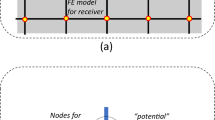Abstract
The objective of this paper is to develop a finite element model for multi-body contact analysis of Cosserat materials. Based on the parametric virtual work principle, a quadratic programming method is developed for finite element analysis of contact problems. The contact problem with friction between two Cosserat bodies is treated in the same way as in plastic analysis. The penalty factors, that are normally introduced into the algorithm for contact analysis, have a direct influence on accuracy of solution. There is no available rule for choosing a reasonable value of these factors for simulation of contact problems of Cosserat materials, and they are therefore cancelled through a special technique so that the numerical results can be of high accuracy. Compared with the conventional work on Cosserat elasticity, the newly developed model is on the contact analysis of the Cosserat materials and is seldom found in the existing literatures. Four examples are computed to illustrate the validity and importance of the model developed.
Similar content being viewed by others
References
Conry TF, Seireg A (1972) A mathematical programming method for design of elastic bodies in contact. J Appl Mech 38:387–392
Cerrolaza M, Sulem J, Elbied A (1999) A Cosserat non-linear finite element analysis software for blocky structures. Adv Eng Software 20:69–83
Chand R, Haug EJ, Rim K (1976) Analysis unbounded contact programming. J Optim Rheory & Appl 120:171–189
Cosserat E, Cosserat F, (1909) Theorie des corps deformables. Hermann, Paris
Cowin SC (1970) Stress functions for Cosserat elasticity. Int J Solids and Struct 6:389–398
De Borst R, Sluys LJ, Mühlhaus HB, Pamin J (1993) Fundamental issues in finite element analyses of localisation of deformation. Eng Comput 10:99–121
Eringen AC (1966) Linear theory of micropolar elasticity. J Math Mech 15:909–923
Fischer U, Melosh RJ (1987) Solving discretized contact problems using linear programming. Comput Struct 25:661–664
Forest S, Barbe F, Cailletaud G (2000) Cosserat modeling of size effects in the mechanical behaviour of polycrystals and multi-phase materials. Int J Solids Struct 37:7105–7126
Grierson DE, Franchi A, Donato O, Corradi L (1979) Mathematical, programming and nonlinear finite element analysis. Comput Meths Appl Mech Eng 17/18,:497–518
Hung NO, Saxce G (1980) Frictionless contact of elastic bodies by finite element method and mathematical programming technique. Comput Struct 11:55–67
Lasry D, Belytschko TB (1988) Localization limiters in transient problems. Int J Solids Struct. 24:581–597
Kikuchi N, Oden JT (1988) Contact problems in elasticity: A study of variational inequalities and finite element methods. SIAM, Philadelphia
Klarbring K (1986) A mathematical programming approach to three dimensional contact problems with friction. Comput Meth Appl Mech Eng 58:175–200
Lee SS (1994) A computational method for frictional contact problem using finite element method. Int J Numer Meth Eng 37:217–228
Maier G (1971) Incremental plastic analysis in the presence of large displacements and physical instabilizing effects. Int J Solids Struct 7:345–372
Maier G (1972) Mathematical programming methods in structural analysis. In: Brebbia, CA (ed) Variational methods in engineering, Southampton University, Southampton, UK
Maier G, Munro J (1982) Mathematical programming applications to engineering plastic analysis. Appl Mech Reviews 35:1631–1642
Mindlin RD (1965) Stress functions for a Cosserat continuum. Int J Soilds Struct 1:265–271
Mühlhaus HB, Vardoulakis I (1987) The thickness of shear band in granular materials. Geotechnique 37:271–283
Providas E, Kattis MA (2002) Finite element method in plane Cosserat elasticity. Comput Struct 80:2059–2069
Read HE, Hegemier GA (1984) Strain softening of rock, soil and concrete- A review article. Mech Mat 3:271–294
Tejchman J, Gudehus G (2001) Shearing of a narrow granular layer with polar quantities. Int J Numer Anal Meth Geomech 25:1–28
Wriggers P (1995) Finite element algorithms for contact problems. Arch Comput Meth Eng 2(4):1–49
Wriggers P (2002) Computational Contact Mechanics. Wiley, New York
Zhang HW (1995) Parametric variational principle for elastic-plastic consolidation analysis of saturated porous media. Int J Numer Anal Meths Geomech 19:851–867
Zhang HW, Galvanetto U, Schrefler BA (1999) Local analysis and global nonlinear behaviour of periodic assemblies of bodies in elastic contact. Comput Mech 24(4): 217–229
Zhang HW, He SY, Li XS, Wriggers P (2004) A new algorithm for numerical solution of 3d elastoplastic contact problems with orthotropic friction law. Computational Mechanics, to appear
Zhang HW, Schrefler BA (2000a) Gradient-dependent plasticity model and dynamic strain localisation analysis of saturated and partially saturated porous media: one dimensional model. European J Solid Mech A/Solids 19(3):503–524
Zhang HW, Schrefler BA (2000b) Global constitutive behaviour of periodic assemblies of inelastic bodies in contact. Mech Composite Mater Struct 7(4):355–382
Zhang HW, Zhong WX, Gu YX (1995) A Combined programming and iteration algorithm for finite element analysis of three-dimensional contact problems. ACTA Mechanic Sinica 11(4):318–326
Zhang HW, Zhong WX, Gu YX (1998) A combined parametric quadratic programming and iteration method for 3D elastic-plastic frictional contact problem analysis. Comput Meth Appl Mech 155:307–324
Zhong WX, Sun SM (1989) A parametric quadratic programming approach to elastic contact problems with friction. Comput Struct 32:37–43
Zhong WX, Zhang RL (1988) Parametric variational principles and their quadratic programming solutions in plasticity. Comput Struct 30:887–896
Zhong WX, Zhang HW, Wu CW, (1997) Parametric Variational Principle and Its Applications in Engineering. Science Press, Beijing
Zhong ZH, Mackerle J (1992) Static contact problems-A review. Eng Comput 9:3–37
Author information
Authors and Affiliations
Corresponding author
Rights and permissions
About this article
Cite this article
Zhang, H.W., Wang, H., Wriggers, P. et al. A finite element model for contact analysis of multiple Cosserat bodies. Comput Mech 36, 444–458 (2005). https://doi.org/10.1007/s00466-005-0680-7
Received:
Accepted:
Published:
Issue Date:
DOI: https://doi.org/10.1007/s00466-005-0680-7




